![]()
![]()
![]()
Use LEFT and RIGHT arrow keys to navigate between flashcards;
Use UP and DOWN arrow keys to flip the card;
H to show hint;
A reads text to speech;
46 Cards in this Set
- Front
- Back
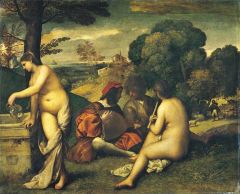
|
•Venetian Art •GIORGIONEda Castelfranco •The Pastoral Concert, oil on canvas, 1508.•Poesia: term used to describe Venetianpainting at this time; painting that operates in the indirect manner of poetry •Alook inward •Distractingus from the troubles of Venice at the time •Paintingsthat are tricky to understand•Venetiansdid not hang out naked •Thesegirls are considered muses, they are imagined, making it ok for them to havenude painting in religious environment in Venice•Startworking on oil on canvas rather than on wood |
|
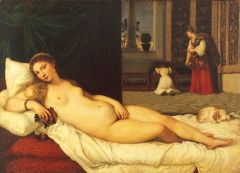
|
Venetian Art •TITIAN •Venusof Urbino, oilon canvas, 1538.•Commissionedby the duke of Urbino •Makingher Venus means its okay she is nude•Originallyshe was just called Nude Woman during the time •Paintingenjoying the erotic nature of the nude •Dogscan be a symbol of lust •Sleepinglust |
|
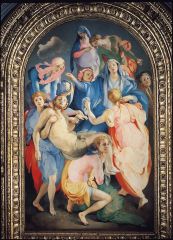
|
MANNERISM: “Maniera” (inthe manner of…) value instability, human forms seem removed from natureemphasis on artifice (artificial), elegance and beauty, imbalance,asymmetrical, ambiguous space, artist must be inventive; messing with someoneelse's style •Jacopode PONTORMO: Descent from the Cross, oilon wood panel, Capponichapel, Florence, 1525-28. •Earlyexample of mannerism •Oddposture •Nobackground; just a single cloud and floorline •Nodeep space •Pastelcolor palette •Figuresdon’t make sense •Artistis purposefully messing around with our expectations •Wedon’t have realistic bodies |
|
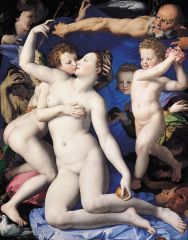
|
Mannerism •BRONZINO:Venus,Cupid, Folly and Time (The Exposure of Luxury), oil on wood, 1546. •Crazypiece •Not aproblem you can’t solve the riddle as to what it means •Onlycharacters you can identify is Venus in the center and cupid who is kissing her |
|
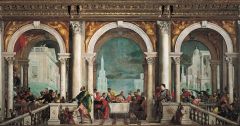
|
Mannerism •VERONESE:Feastin the House of Levi,oil on canvas, refectory of Santi Giovanni, Venice, 1573. •Veronesecompletes painting of last supper; could have been one of the largestpaintings; it offended the holy office of the inquisition•Inquisistion:theexpulsion of competing religions; time when people were hunted down if theydidn’t believe orthodox belief•Lastsupper looks more like a party •Tonsof people •Doeshave traditional composition of Christ and disciples on the table includingJudas, but we also have too many figures •Inclusionof jesters, dwarves, drunken Germans, guy picking his teeth •Catholicchurch was worried about anything that would give reason for protestants tomake fun of their religion •Veronesechanges the name to the feast of house of Levi that makes much more sense tohave sinners in painting |
|

|
16thCENTURY NORTHERN EUROPEAN ART •HieronymousBOSCH, Gardenof Earthly Delights,oil on wood, 1505-1510. •Kindof looks like an alter piece; made in traditional form •Wasn’tin a church but rather a private home•Could be a wedding present •Leftis garden of Eden •Big pink crazy fountain •Rightis hell • 7feet high •Boschengineered fountains •Tookan interest in alchemy •Messagethat humans are stupid and things get crazy and we must pay the price •Peopleneed to be saved by themeselves |
|
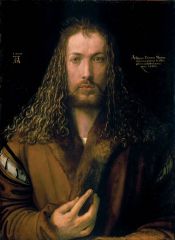
|
16th CENTURY NORTHERN EUROPEAN ART •Selfportrait of Albrecht DÜRER •AlbrechtDÜRER•Self-Portrait,oilon wood, 1500 |
|
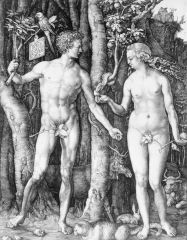
|
16th CENTURY NORTHERN EUROPEAN ART •TheFall of Man (Adam and Eve), engraving, 1504•Prereformation •AlbrechtDÜRER •Studyof canon of proportion •Intensedetail to body but also background pieces •Medievaltheory of the bodily humors (bodily fluids) •Reflectedon the animals •Afterfall of man we became susceptive to bodily fluids |
|
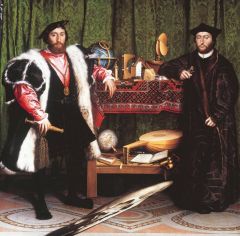
|
16th CENTURY NORTHERN EUROPEAN ART •HansHOLBEIN THE YOUNGER, The French Ambassadors, oiland tempera on wood, 1533.•AnamorphicImage: distortionof perspective in a painting (the skull on this painting)•Dividedin four quadrants: •Topis the heavens/celestial •Bottomis the earth/terrestrial •Leftis the active •Rightis the contemplative •MomentoMori: reminderof death |
|
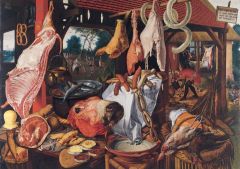
|
16th CENTURY NORTHERN EUROPEAN ART •PieterAERTSEN, MeatStill-life, oilon panel, 1551. •Genresof Paintings •Religious •Historical •Mythological •Portraiture •Landscape •Stilllife •Northerneuropeansreverse the hierarchy of importance to painting genre •Messageof being generous in the background based on Mary’s escape before they killedthe babies |
|
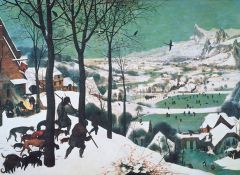
|
16th CENTURY NORTHERN EUROPEAN ART •PieterBRUEGHEL THE ELDER, Hunters in the Snow, oilon wood panel, 1565. •Madeof set of paintings that would represent the seasons •Huntersreturning from a not so successful hunt •Landscapescene seen from everyday life•Concentratedarea in the foreground balanced by the beautiful background •Deepspace on the right area •Coldappearance very well captured |
|
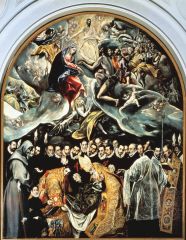
|
16thCENTURY SPAIN •ELGRECO TheBurial of Count Orgaz, oil on canvas, 1586.•Heis greek butspent most of his career in spain •Considereda spaniardmannerist•Commissionedby a preist •Count orgaz gave money to this church•Count orgaz is in the painting in honor of hispassing away •St augustin and st ???? Carry the count to the heavens •Divisionof earthly and heavenly realm •Johnthe babtistright •Maryleft •Jesustop center •Holyfigures are more perfectioned intononhumans (halos are left behind) rather than straight naturalism |
|

|
ITALIAN BAROQUE ART •Carracci •Lovesofthe Gods,ceiling frescoes, Palazzo Farnese, Rome, 1597-1601 •Arrivalof Baccus •Mythologicalcreatures celebrating •Nothingreligious all pagan •Backto an era of humanism•Lovesof the Gods |
|
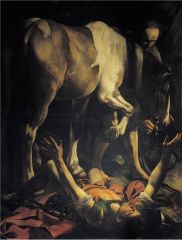
|
ITALIAN BAROQUE •CARAVAGGIO •Conversionof St. Paul, Cerasichapel, Santa Maria del Popolo,Rome, oil on canvas, 1601•St.Paul is converted •Saul was his original name •He was struck blind while riding a horse •A voice ask “why are you against me”•Converts to St. paul •Climatic scene of paulfalling off horse blind in present rome 1600s •Notmuch background space in Caravaggio works •Tennebrism:extreme use of blacks and lights |
|
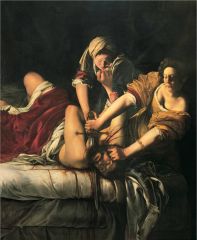
|
ITALIAN BAROQUE •ArtemisiaGENTILESCHI •JudithSlaying Holofernes, oil on canvas, 1620•Holofernesis an assyriangeneral destroying lands •Isreal isworried •Judithis a widow •Shecomes up with a plan •Travelto see holofernes •Saysshe is a traitor and here to give him info about the area and how to defeatthem •Shegets close to him •Getshim drunk •Cutsoff his head to bring proof she killed him•Not alot of background •Actionright in our face •Consideredjewishheroine |
|

|
ITALIAN BAROQUE •Dynamicartist •GianlorenzoBERNINI •Rapeof Proserpina, 1621-22 •Apprenticeto his father •Becomea prodigy at a young age •Knownfor turning stone into flesh•Proserpinais the daughter of Ceris (godof harvest) •Pluto(god of the underworld) gets shot by an arrow by cupid •Proserpinaaccidently eats three seeds of a pomegranate •You cannot eat the food of the undead •Plutolets her get custody of her daughter during certain seasons |
|

|
ITALIAN BAROQUE dynamic artist •GianlorenzoBERNINI •Apolloand Daphne, 1622-25 •Apollois shot by an arrow from cupid •Apollowants daphne •Daphnecalls her father for help •Daphneturns into a tree once Apollo touches her •Fingersbegin to sprout leaves |
|
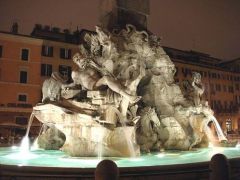
|
ITALIAN BAROQUE dynamic artist GianlorenzoBERNINI Fontana dei Quattro Fiumi (Fountain of Four Rivers), Piazza Navona, 1648-51 |
|
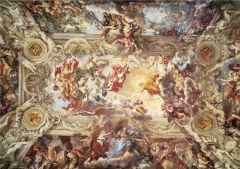
|
ITALIAN BAROQUE Pietro DACORTONA: Triumph of the Barberini, ceiling fresco, Palazzo Barberini, Rome, 1632-39 |
|
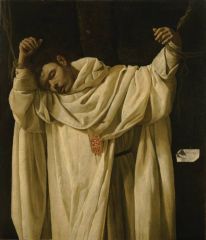
|
SPANISH BAROQUE Francisco de ZURBARAN: SaintSerapion, oil on canvas, 1628H |
|
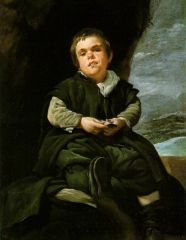
|
SPANISH BAROQUE Diego VELAZQUEZ Boy of Vallecas, oil on canvas, 1642-45> |
|

|
SPANISH BAROQUE Diego VELAZQUEZ Las Meninas (Maids in Waiting), oil on canvas, 1656 |
|

|
DUTCH BAROQUE Gerrit VAN HONTHORST: SupperParty, oil on canvas, 1620 |
|
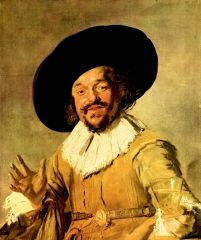
|
DUTCH BAROQUE Frans HALS Jolly Toper, oil on canvas, 1627 |
|
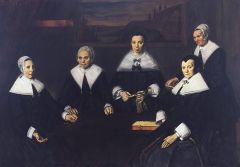
|
DUTCH BAROQUE Frans Hals The Women Regents of the OldMen’s Home at Haarlem, oil on canvas, 1664 |
|
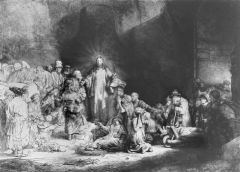
|
DUTCH BAROQUE REMBRANDT van Rijn Christ with Sick Around Him(Hundred Guilder Print), etching, 1649 |
|
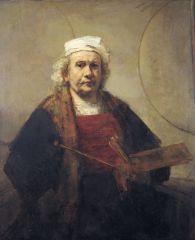
|
DUTCH BAROQUE REMBRANDT van Rijn Self-Portrait, oil on canvas, 1660 |
|
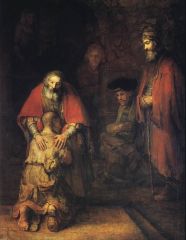
|
DUTCH BAROQUE REMBRANDT van Rijn Return of the Prodigal Son, oil on canvas, 1665 |
|
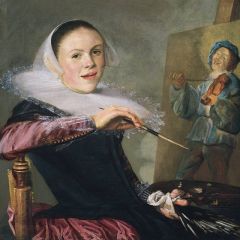
|
DUTCH BAROQUE Judith LEYSTER Self-Portrait, oil on canvas, 1630 |
|
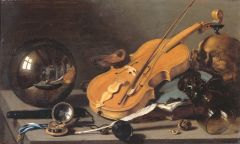
|
DUTCH BAROQUE Pieter CLAESZ: Vanitas Still life,oil on panel, 1630’s |
|
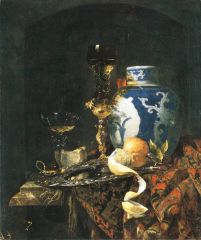
|
DUTCH BAROQUE Willem KALF: Still life with MingGinger Jar, oil on canvas, 1669 |
|
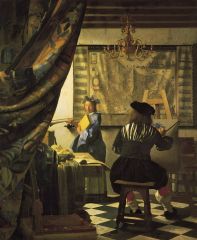
|
DUTCH BAROQUE Jan VERMEER Allegory of the Art of Painting, oil on canvas, 1670-75 |
|
|
Mannerism |
MANNERISM: “Maniera” (inthe manner of…) value instability, human forms seem removed from natureemphasis on artifice (artificial), elegance and beauty, imbalance,asymmetrical, ambiguous space, artist must be inventive; messing with someoneelse's style |
|
|
1517: Protestant Reformation: |
•Martin Luther createsthe 95theses thatcomplains about the catholic church especially the act of indulgenceswhichare the selling of getting out of time in purgatory •Translates the bible into German •Dismantles the hierarchy of the church •The common people can understand thebible •People can be closer to god without thehelp of other people •Is declared heretic for his desire tochange the church even though we was a devoted catholic |
|
|
Council of Trent 1545-1563 |
•aresponse for the protestant reformation in order to address the complaintsagainst the church•Council seeks to make art appeal to thecommon folk so they cannot relate |
|
|
ALBRECHT DÜRER |
Travelled widely through Europe andbecame an international celebrityTook trips to Italy to studyRenaissance artFirst artist to synthesize NorthernEuropean stylistic features (intricate detail, realistic rendering of objects,symbols hidden as everyday objects) and blend them with Italian features(classical body types, linear perspective) --- admired the work of LeonardoFirst artist to keep a thoroughrecord of his life (self-portraits, treatises on his thoughts, and a diary)Important graphic artist --- bestknown for his engravingsInfluenced significantly by MartinLuther and Protestant Reformation |
|
|
woodcut |
printmaking technique engraving wood |
|
|
engraving |
using metal plate to print |
|
|
anamorphic image |
distoration of perspective in a painting |
|
|
memento mori |
reminder of death |
|
|
Annibale CARRACCI |
italian classicist baroque Councilof trent wasa meeting by leaders of the catholic church trying to make a way to counter thereformation•Carracciwas two brothers and a cousin•Familyopened the first art academy•Annibale wasrescuing italian artfrom mannerism•Tryingto pick up where classist left off |
|
|
Caravaggio |
italian Realist baroque •born near milan•Moves to rome to become serious painter•Early works is about the struggle aboutbeing a painter•Early works uses himself as a model(because he is broke)•Many of his works is very erotic in somesense•Taste for the young male body beingattractive to both older men and women •Knownfor making religious pictures relatable to the common people•Peopleare dressed as romans in 1601 (the present time of the painting and place) |
|
|
Tennebrism |
extreme use of black and lights |
|
|
Caravaggisti |
follower of Caravaggio |
|
|
GianlorenzoBERNINI |
dynamic artist of italian baroque known for making stone into flesh |
|
|
baroque |
rather a time period than an art style focus on climatic scenes beautiful scenes of classic stories seen with fresh eyes •17th century time period it more of a timeperiod than a stlye ofart for there is to many variations going on at the time(1600-1700) |

